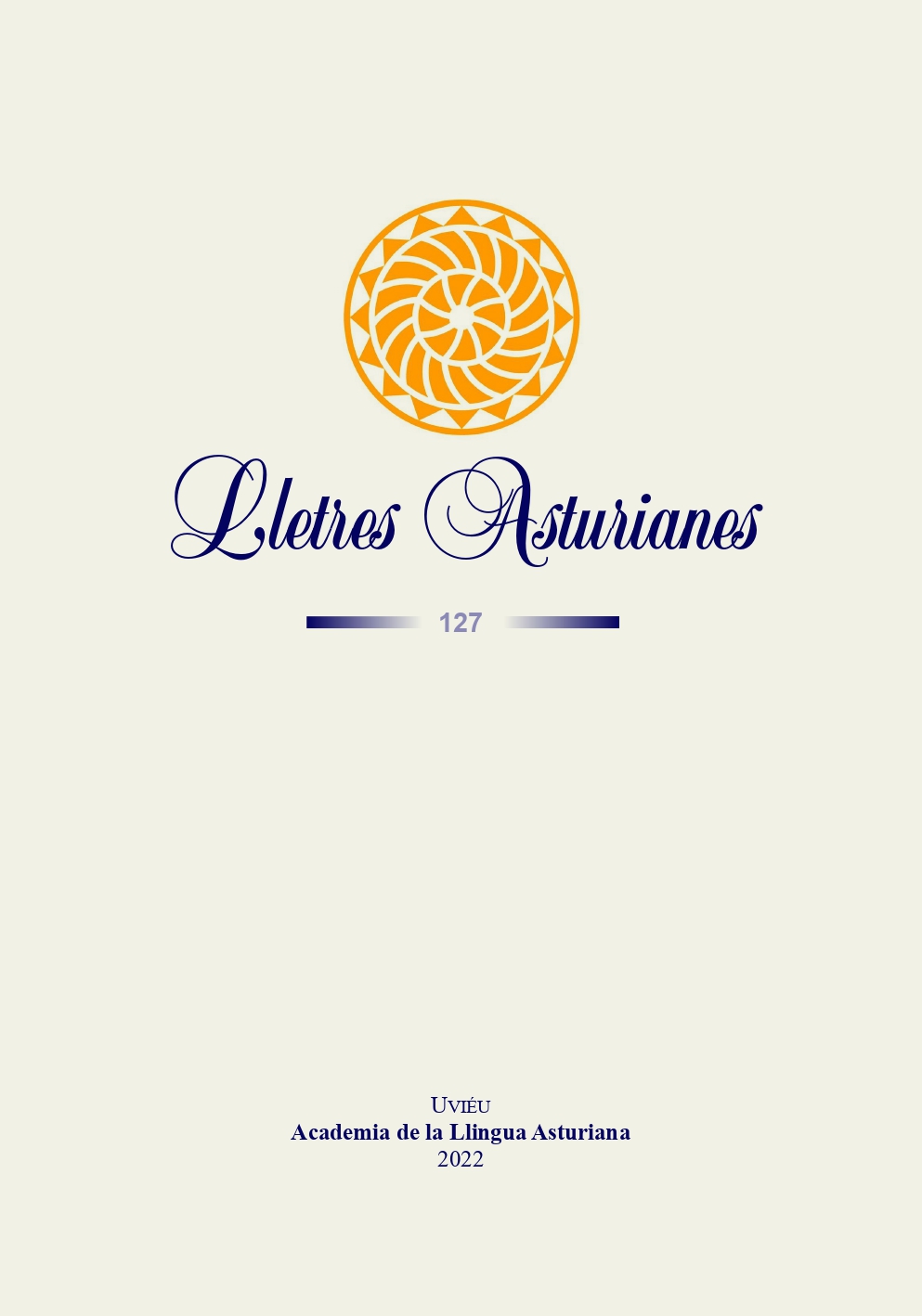Resumen
Esti artículu analiza la recuperación de la tradición y les nueves formes d’activismu y texíu de redes comunitaries na música n’Asturies tres de la crisis financiera de 2008. Col estudiu específicu d’artistes como Rodrigo Cuevas, ún de los nuevos músicos con mayor reconocencia dientro y fuera d’Asturies; Ún de Grao, el proyeutu musical de Xosé Martínez Álvarez; miembru de la conocida como xeneración «post-folk», que busca dar puxu otra vuelta a la tonada; y el Coru Al Altu la Lleva, que, nacíu de l’atmósfera de l’asociación Caja de músicos, sigue cola tradición de la música coral poniendo un procuru especial nel activismu, mesmo xunto al perconocíu músicu asturianu Nacho Vegas que de manera independiente.
La música asturiana de recién amuesa tendencies nueves na so rellación col tiempu y l’espaciu. Músicos y músiques busquen participar de manera global, ensin dilise en patrones definíos, al traviés de les sos diferencies y activismu. Dalgunos de los problemes colos que los músicos y músiques s’identifiquen son el papel que xueguen les llingües y cultures que conviven nun territoriu, el revivir un pasáu cuestionando ciertes idees de xeneraciones anteriores, la reconocencia de la diversidá sexual, la tendencia neorrural depués de la depresión económica y la pandemia y la medra del activismu comunitariu depués del movimientu de los Indignados resultáu de la crisis financiera de 2008. Pel camín de la música, Asturies y la llingua asturiana participen y respuenden a les tendencies locales, nacionales ya internacionales que, sofitaes na tradición, creen maneres úniques de resignificación del pasáu y d’influyencia del presente y del futuru.
Citas
Arrones Peon, L. (1978). Historia coral de Asturias. Biblioteca Popular Asturiana.
Barreiro, D. (2016). Entrevista a Rodrigo Cuevas. Anuariu de la Música Asturiana, 44-55.
Barreiro, D. (2016). Entrevista a Rodrigo Cuevas. Anuariu de la Música Asturiana, 44-51.
Barreiro, D. (2016). ¿La tercer revolución del folk asturianu? Anuariu de la Música Asturiana, 14-19.
Barreiro, D. (2019). Morrió’l celtismu, ¡puxa’l celtismu! Anuariu de la Música Asturiana, 16-21.
Barrero, M. (2016). La tinta del calamar: Tragedia y mito de Rambal. Trea.
Boym, S. (2001). The Future of Nostalgia. Basic Books.
Braga, H. (2020). La asturianada. Estudio etnomusicológico de un género vocal de tipología popular. [Doctoral Dissertation, University of Oviedo].
Carrasco, J. (2013). Intemperie. Seix Barral.
Carne Cruda. (2020). Carne Cruda en FICX 2020 con Rodrigo Cuevas | Programa completo #769. YouTube. https://www.youtube.com/watch?v=4i8lZLk0SFI&ab_channel=CarneCruda
Cohen, J. J. (2015). Stone: An Ecology of the Inhuman. University of Minnesota Press.
Colmeiro, J. (2017). Peripheral Visions / Global Sounds: From Galicia to the World. Liverpool Uni-versity Press.
Cruz, N. (2017, November 10). Rodrigo Cuevas: “Vomitar mierda contra los demás es facilísimo”. elPeriódico. https://www.elperiodico.com/es/ocio-y-cultura/20171110/rodrigo-cuevas-entrevista-folclore-tecno-cabaret-6414811
Cuevas, Rodrigo. (2021, July 1). Rodrigo Cuevas https://rodrigocuevas.sexy/
Domingo, I. (2017). Remembering Paco Ibáñez at the Olympia: A political communitas in exi-le. Journal of European Studies, 47(3), 259-274.
Durán Rodríguez, J. (2020, May 31). Al Altu la Lleva, un coro antifascista, internacional y feminista en Gijón. El Salto Diario. https://www.elsaltodiario.com/musica/coro-antifascista-obrero-feminista-altu-lleva-gijon
Elipe, X. (2018). Cantares de llucha. Reivindicación, compromiso y política. Cultures, 22: 179-191.
Elipe, X. (2021). Hai una llinia trazada: Historia de la música asturiana. Trabe.
Frith, S. (1996). Performing Rites: On the Value of Popular Music. Harvard University Press.
Frith, S. (2016). Taking Popular Music Seriously. Routledge.
García Flórez, L. (2020). Les 30 Asturianaes de Carlos Rubiera. Cartografía d’una escucha posible. In Rubiera, C. 30 Asturianaes (pp. 17-25). Goxe Producciones.
García Postigo, M. & Campos, F. (Directors). (2015). Rodrigo Cuevas. Campo y tablas. Mediaexin
la música amanseix les feres. (2019, April 2). Entrevistem al asturià “Ún de Grao”. http://lamusicaamanseixlesferes.blogspot.com/2019/04/entrevistem-al-asturia-un-de-grao.html
Lorenzo, S. (2018). Los asquerosos. Blackie Books.
Martínez Expósito, A. (2019). Cuestiones de imagología en el cine hecho en Asturias en el siglo XXI / Questions of Imagology in the cinema made in Asturies in the 21st century. Lletres Asturianes, 120, 145-170.
Ministerio de Igualdad. (2022, June 16). 2º Reconocimientos Arcoíris a personas destacadas en la visibilización, apoyo y defensa de los derechos de las personas LGTBI. https://www.igualdad.gob.es/comunicacion/notasprensa/Paginas/2-reconocimientos-arcoiris-personas-lgtbi.aspx
Moreno-Caballud, L. (2015). Cultures of Anyone: Studies on Cultural Democratization in the Spanish Neoliberal Crisis. Liverpool University Press.
Morton, T. (2010). The Ecological Thought. Harvard University Press.
Músicasturiana. (2022, June 22). «El celtismu ye la construcción intelectual sobre la identidá que calistró más fondamente y con más eficacia na mentalidá popular». https://musicasturiana.com/el-celtismu-ye-la-construccion-intelectual-sobre-la-identida-que-calistro-mas-fondamente-y-con-mas-eficacia-na-mentalida-popu-lar/?fbclid=IwAR17fneEa4QsAHS1bGz27CXfUC3_47aBCL3kgfhNJ99_qEWMw16Qzzhpyso
Nogué, J. (2012). Neo-ruralism in the European context. Origins and evolution, In J. R. Resina & W. R. Viestenz (Eds.), The New Ruralism. An Epistemology of Transformed Spain (pp. 29-41). Ibe-roamericana Vervuert.
Ojo Crítico, El (RNE) [ElOjoCriticoRNE]. (2022, May, 30). DIRECTO | Rodrigo Cuevas (@RodrigoCuevasG), premio ‘El Ojo Crítico de Música Moderna’ “Es un reconocimiento a to-das esas personas que cantan [Tweet; video]. Twitter. https://twitter.com/ElOjoCriticoRNE/status/1531313391901593600
Programa Pieces TPA. (2021, March 8). Coru antifacista al altu la lleva – La cadena del amor [Video]. FaceBook. https://www.facebook.com/watch/?v=2952316755089908
Reverter, A., Tolivar, A.C, Martínez, C. J., Menéndez del Campo, R. & Morán, N. (2008). Voces de Gijón. Piraña Family Producciones.
Rubiera, C. (2020). 30 Asturianaes. Goxe Producciones.
Sánchez, M. (2019). Tierra de mujeres: Una mirada íntima y familiar al mundo rural. Seix Barral.
Sánchez Vicente, P. (2018) Mujeres errantes. Roca Editorial.
Simón, A. I. (2020). Feria. Círculo de tiza.
Sr. Paraguas. (2019, March 2). Muyeres de la clas obrera – Coru Internacional Antifascista Al altu la lleva [Video]. YouTube. https://www.youtube.com/watch?v=tItBFU-t9Qw&ab_channel=SrParaguas
Turner, V. (1977). The Ritual Process: Structure and Anti-Structure. Cornell University Press.
Wiggin, B., Fornoff, C., & Kim, P. E. (2020). Timescales: Thinking Across Ecological Temporalities. University of Minnesota Press.

